Pooja Chitkara
Synthetic Cross-accent Data Augmentation for Automatic Speech Recognition
Mar 01, 2023


Abstract:The awareness for biased ASR datasets or models has increased notably in recent years. Even for English, despite a vast amount of available training data, systems perform worse for non-native speakers. In this work, we improve an accent-conversion model (ACM) which transforms native US-English speech into accented pronunciation. We include phonetic knowledge in the ACM training to provide accurate feedback about how well certain pronunciation patterns were recovered in the synthesized waveform. Furthermore, we investigate the feasibility of learned accent representations instead of static embeddings. Generated data was then used to train two state-of-the-art ASR systems. We evaluated our approach on native and non-native English datasets and found that synthetically accented data helped the ASR to better understand speech from seen accents. This observation did not translate to unseen accents, and it was not observed for a model that had been pre-trained exclusively with native speech.
Pushing the performances of ASR models on English and Spanish accents
Dec 22, 2022Abstract:Speech to text models tend to be trained and evaluated against a single target accent. This is especially true for English for which native speakers from the United States became the main benchmark. In this work, we are going to show how two simple methods: pre-trained embeddings and auxiliary classification losses can improve the performance of ASR systems. We are looking for upgrades as universal as possible and therefore we will explore their impact on several models architectures and several languages.
Improving Data Driven Inverse Text Normalization using Data Augmentation
Jul 20, 2022
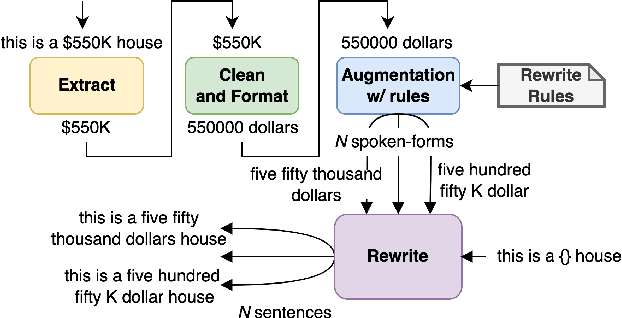

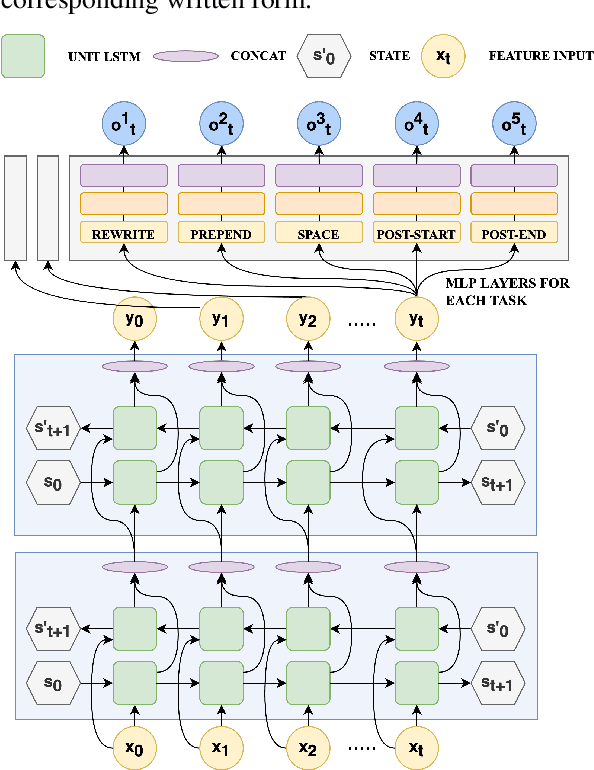
Abstract:Inverse text normalization (ITN) is used to convert the spoken form output of an automatic speech recognition (ASR) system to a written form. Traditional handcrafted ITN rules can be complex to transcribe and maintain. Meanwhile neural modeling approaches require quality large-scale spoken-written pair examples in the same or similar domain as the ASR system (in-domain data), to train. Both these approaches require costly and complex annotations. In this paper, we present a data augmentation technique that effectively generates rich spoken-written numeric pairs from out-of-domain textual data with minimal human annotation. We empirically demonstrate that ITN model trained using our data augmentation technique consistently outperform ITN model trained using only in-domain data across all numeric surfaces like cardinal, currency, and fraction, by an overall accuracy of 14.44%.
Towards Measuring Fairness in Speech Recognition: Casual Conversations Dataset Transcriptions
Nov 18, 2021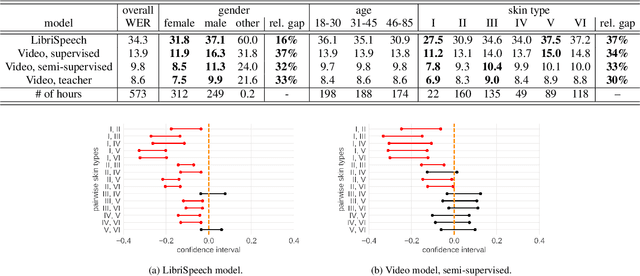

Abstract:It is well known that many machine learning systems demonstrate bias towards specific groups of individuals. This problem has been studied extensively in the Facial Recognition area, but much less so in Automatic Speech Recognition (ASR). This paper presents initial Speech Recognition results on "Casual Conversations" -- a publicly released 846 hour corpus designed to help researchers evaluate their computer vision and audio models for accuracy across a diverse set of metadata, including age, gender, and skin tone. The entire corpus has been manually transcribed, allowing for detailed ASR evaluations across these metadata. Multiple ASR models are evaluated, including models trained on LibriSpeech, 14,000 hour transcribed, and over 2 million hour untranscribed social media videos. Significant differences in word error rate across gender and skin tone are observed at times for all models. We are releasing human transcripts from the Casual Conversations dataset to encourage the community to develop a variety of techniques to reduce these statistical biases.
Accent-Robust Automatic Speech Recognition Using Supervised and Unsupervised Wav2vec Embeddings
Oct 08, 2021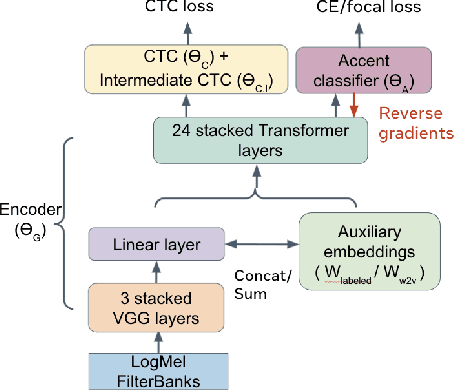
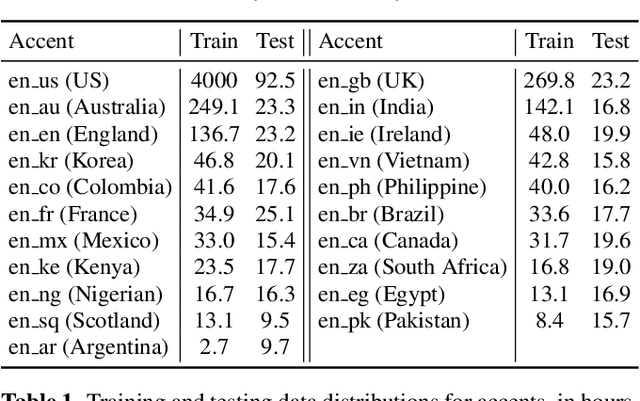
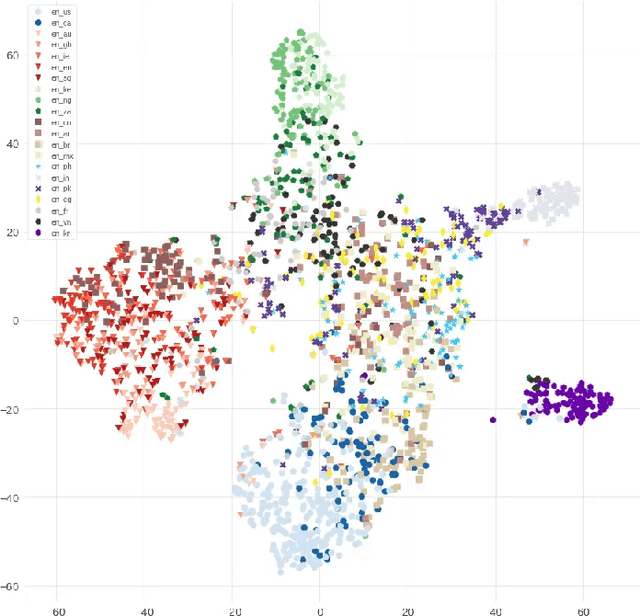

Abstract:Speech recognition models often obtain degraded performance when tested on speech with unseen accents. Domain-adversarial training (DAT) and multi-task learning (MTL) are two common approaches for building accent-robust ASR models. ASR models using accent embeddings is another approach for improving robustness to accents. In this study, we perform systematic comparisons of DAT and MTL approaches using a large volume of English accent corpus (4000 hours of US English speech and 1244 hours of 20 non-US-English accents speech). We explore embeddings trained under supervised and unsupervised settings: a separate embedding matrix trained using accent labels, and embeddings extracted from a fine-tuned wav2vec model. We find that our DAT model trained with supervised embeddings achieves the best performance overall and consistently provides benefits for all testing datasets, and our MTL model trained with wav2vec embeddings are helpful learning accent-invariant features and improving novel/unseen accents. We also illustrate that wav2vec embeddings have more advantages for building accent-robust ASR when no accent labels are available for training supervised embeddings.
Using Pause Information for More Accurate Entity Recognition
Sep 27, 2021
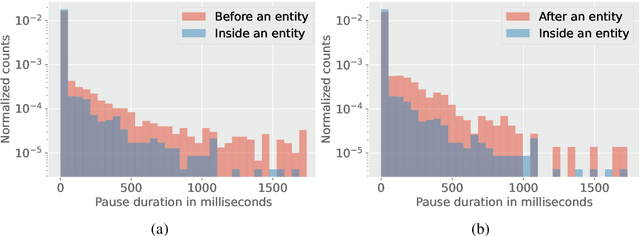

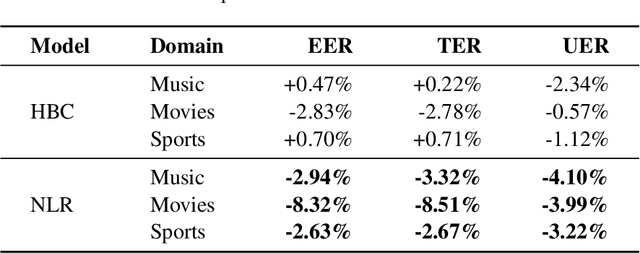
Abstract:Entity tags in human-machine dialog are integral to natural language understanding (NLU) tasks in conversational assistants. However, current systems struggle to accurately parse spoken queries with the typical use of text input alone, and often fail to understand the user intent. Previous work in linguistics has identified a cross-language tendency for longer speech pauses surrounding nouns as compared to verbs. We demonstrate that the linguistic observation on pauses can be used to improve accuracy in machine-learnt language understanding tasks. Analysis of pauses in French and English utterances from a commercial voice assistant shows the statistically significant difference in pause duration around multi-token entity span boundaries compared to within entity spans. Additionally, in contrast to text-based NLU, we apply pause duration to enrich contextual embeddings to improve shallow parsing of entities. Results show that our proposed novel embeddings improve the relative error rate by up to 8% consistently across three domains for French, without any added annotation or alignment costs to the parser.
Topic Spotting using Hierarchical Networks with Self Attention
Apr 04, 2019



Abstract:Success of deep learning techniques have renewed the interest in development of dialogue systems. However, current systems struggle to have consistent long term conversations with the users and fail to build rapport. Topic spotting, the task of automatically inferring the topic of a conversation, has been shown to be helpful in making a dialog system more engaging and efficient. We propose a hierarchical model with self attention for topic spotting. Experiments on the Switchboard corpus show the superior performance of our model over previously proposed techniques for topic spotting and deep models for text classification. Additionally, in contrast to offline processing of dialog, we also analyze the performance of our model in a more realistic setting i.e. in an online setting where the topic is identified in real time as the dialog progresses. Results show that our model is able to generalize even with limited information in the online setting.
 Add to Chrome
Add to Chrome Add to Firefox
Add to Firefox Add to Edge
Add to Edge